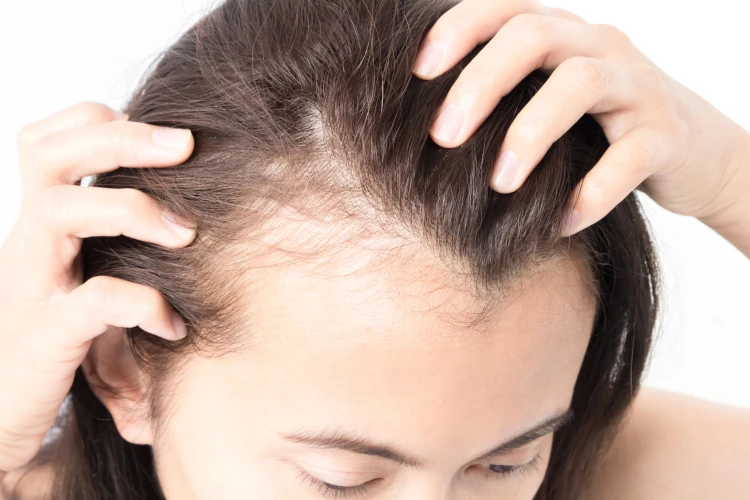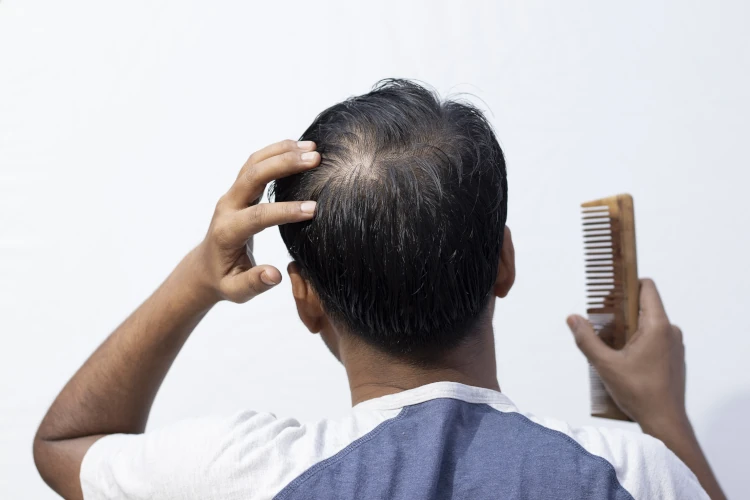
Link Between Diabetes and Hair Thinning
People often talk about nerve damage, kidney issues, and vision problems with diabetes, but not many focus on its impact on hair and scalp health. Yet, many individuals living with diabetes will tell you that one of their early and most distressing signs that something deeper was happening within their bodies was hair loss and thinning.
Understanding how diabetes influences the hair growth cycle and what you can do about it is fundamental for managing both your health and confidence.
How Diabetes Affects Hair Growth Cycles
Hair normally cycles through anagen (growth), catagen (transition), telogen (rest), and exogen (shedding). If you’re healthy, this cycle is smooth, with most of your hair staying in the growth phase for years before naturally shedding and being replaced.
However, when you’re living with a health condition like diabetes, your hair cycle is disrupted in a few ways. High blood sugar levels can damage small blood vessels over time, contributing to microvascular impairment around follicles and reducing the supply of oxygen and nutrients that get to your hair. Inadequately nourished hair follicles can enter a resting or dormant phase prematurely, leading to slower growth and more shedding.
Persistent hyperglycemia or elevated blood sugar can delay the regrowth of new hair after natural shedding. Over time, you’ll notice visible thinning and fewer hairs actively growing to replace those that fall out. Many people living with diabetes report that even when their hair regrows, it does so slowly.
Certain diabetes medications can also change how your hair grows. For instance, Metformin is commonly prescribed for type 2 diabetes, but it’s been associated with nutrient depletion — specifically vitamin B12 — which may indirectly affect hair health. Long-term Metformin use lowers serum B12 in up to 20-30% of users; severe deficiency can manifest as diffuse telogen effluvium. Periodic B12 monitoring is recommended.
In Wegovy (semaglutide) trials, alopecia occurred in about 3% of participants versus 1% placebo. Experts attribute this to telogen effluvium from rapid weight loss rather than a direct drug effect; hair regrows once weight stabilizes.
This is because rapid weight loss can trigger a condition called telogen effluvium, where your hair sheds because you’re stressed. And you might experience nutrient deficiencies and hormonal changes that could lead to hair thinning as well.
What Are the Common Signs of Diabetes Hair Loss?

Unlike classic baldness patterns, where you get receding hairlines or crown thinning, diabetes-related hair loss tends to appear as diffuse thinning, a general reduction in hair density across the scalp. You might notice your ponytail becoming thinner or that your scalp is more visible through previously dense areas.
Diabetes doesn’t limit hair loss to the scalp either. You might see a decent amount of hair loss on your arms, legs, or face. It’s especially common in areas with smaller blood vessels, where circulation is lacking.
Consistent shedding of more than 100 hairs per day warrants evaluation; diabetes is one of several possible contributors, alongside things like thyroid imbalance, iron deficiency, acute illness, medications, and more.
Underlying Causes of Hair Thinning in People With Diabetes
As mentioned, weakened blood flow to the scalp and extremities can directly impact hair follicle performance. In addition, insulin resistance can alter your hormone levels and trigger inflammatory processes that disturb the hair growth cycle.
Type 1 diabetes, in particular, is an autoimmune condition. People living with autoimmune disorders are more prone to other immune-related conditions, such as alopecia areata (AA). Pooled data show AA in about 1-3% of patients with type 1 diabetes versus about 0.1-0.2 % in the general population.
Diabetes can lead to imbalances in hormones like cortisol, thyroid hormones, and insulin itself, all of which play a role in how your hair grows. Poorly controlled diabetes can impair absorption or increase urinary loss of micronutrients (e.g., zinc, magnesium); however, population studies show mixed results. Screen only when clinical suspicion exists.
Poor sleep, chronic stress, and the consumption of certain foods or beverages can affect both diabetes management and hair health.
Even weight loss can be linked to hair thinning because of the telogen effluvium it might trigger, and the hormonal changes and essential nutrient deficiencies that can come with it.
Treatment Options for Hair Loss Related to Diabetes
While managing diabetes is key to controlling hair loss, you have a few treatment options that can also help. For instance, minoxidil is an FDA-approved treatment that stimulates hair follicles, though results vary and regular use is required.
Biotin supplements are another option, as they support hair structure and strength. Taking them is generally considered safe but they should still be taken under medical supervision. More than 5 milligrams per day of biotin can artificially lower troponin and TSH assays; inform medical professionals if you’re taking it. Or, you could go with multivitamins that include zinc, iron, and B-complex vitamins to improve hair health, particularly if you’re experiencing any nutrient deficiencies.
If your thinning is more intense, hair transplant surgery is an option. How surgeons approach hair transplants in patients with diabetes looks a little different than in those who don’t, and there are various risks to be aware of. However, a reputable clinic will ensure you undergo a successful hair transplantation with proper preoperative evaluation.
In the U.S., a 2,000-graft follicular unit extraction or follicular unit transplantation procedure averages $7,000–$13,000, varying by region and technique. You can also expect noticeable results after six to 12 months of recovery time.
Managing Diabetes To Minimize Hair Thinning
Preventing and reducing hair loss ultimately comes down to how well you manage your diabetes.
Keep your blood sugar within your target range to reduce inflammation and support healthy blood circulation for hair follicle health. It’s also best to follow your provider’s advice on what diet to eat, what medication to take, and how much physical activity you should get.
Stress can trigger hormonal changes that worsen both blood sugar control and hair shedding. So, try meditation, yoga, journaling, or cognitive behavioral therapy (CBT) to keep your stress in check.
Watching your hair thin can make you feel really defeated. But it’s manageable, and in some cases, reversible, with the right combination of medical care and lifestyle changes. Stay proactive, be gentle with yourself, and know that support and treatment options are available at every stage.


